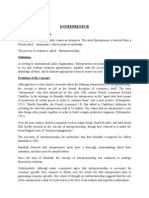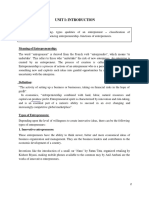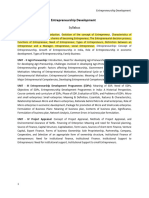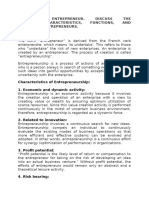Enter Pre Nuer
Enter Pre Nuer
Uploaded by
Nadeem GanaiCopyright:
Available Formats
Enter Pre Nuer
Enter Pre Nuer
Uploaded by
Nadeem GanaiOriginal Description:
Copyright
Available Formats
Share this document
Did you find this document useful?
Is this content inappropriate?
Copyright:
Available Formats
Enter Pre Nuer
Enter Pre Nuer
Uploaded by
Nadeem GanaiCopyright:
Available Formats
Qno1.
Meaning of an Entrepreneur The word entrepreneur is derived from the French word Entreprendre which means to undertake i.e., individuals who undertake the risk of new enterprise. The word entrepreneur, therefore, first appeared in the French language in the beginning of the sixteenth century. According to Cantilon, An entrepreneur is a person who buys factor services at certain prices with a view to selling its product at uncertain prices. According to J.B. Say, an entrepreneur is the agent who unites all the factors of production and who finds in value of the products the re-establishment of the entire capital the employees, and the value of wages, the interest and the rent which he plays as well as the profits belonging to himself. He may or may not supply capital but he must have judgement, perseverance and the knowledge of the world of business. He must possess the art of superintendence and administration. According to F.H. Knight, entrepreneurs are a specialized group of persons who bear risks and deal with uncertainty, According to Peter F. Drucker, defines an entrepreneur as one who always searches for change, responds to it and exploits it as an opportunity. According to International Labour Organization (ILO), defines entrepreneurs as those people who have the ability to see and evaluate business opportunities, together with the necessary resources to take advantage to them and to initiate action to ensure success. Thus, it is clear from the above definitions, that an entrepreneur is a visionary and an integrated man with outstanding leadership qualities with a desire to excel, the entrepreneur, gives top priority to Research and development. He always works for the well-being of the society. Entrepreneur is one creates his own business. An entrepreneur is a person who perceives a need and then brings together manpower, material and capital required to meet the need. Qno2. Characteristics of successful Entrepreneurs Characteristics Traits Self-confidence Confidence, independence, individuality, optimism Task-oriented Need for achievement, profit-oriented persistence, perseverance, determination, hard-work, drive, energy, initiative. Risk bearer Risk-taking ability, likes challenges Leadership Leadership behavior gets along well with others, responsive to suggestions and criticisms. Originality Innovative, creative, flexible, resourceful, versatile, knowledgeable. Future-oriented Foresight perceptive Qno3. Activities or Functions of Entrepreneurs An entrepreneur begins activating his mind and senses taking from the time he dreams of his own venture till the time he actually achieves his dream. His primary functions include seeking opportunities, organizing and co-coordinating agents/ factors of production mobilizing resources and so on. Thus, it can be concluded that an entrepreneur has to act as mother who give birth to an enterprise as well as a father it going on after taking due care of it. The main functions of the entrepreneurs are gives by different expert such as:Kilbys thirteen functions of entrepreneurs divided into four groups as follows: A. Exchange Relationship:1. Perceiving market opportunities 2. Gaining command over scarce resources 3. Purchasing inputs 4. Marketing of the products and responding to competition. B. Political Administration:-
1. Dealing with the public bureaucracy (concession, licenses and taxes) 2. Managing human relation within the firm. 3. Managing customer and supplier relations. C. Managing Control:1. Managing finance 2. Managing production. D. Technology:1. Acquiring and overseeing assembly of the factory 2. Industrial engineering. 3. Upgrading process and product quality. 4. Introducing new production techniques and products. Diagrammatical presentation:Functions of Entrepreneurs Entrepren. Functions Promotional Functions Managerial Functions Innovation Risk taking Organization building Discovery of an idea Detailed investigation Assembling the requirements Financing the proposition Planning Organizing Staffing Directing Leadership Communication Motivation Co-ordination Controlling
Commercial Functions Production Marketing Personnel Accounting Finance
Qno4. Types of Entrepreneurs Different experts gave different classification of entrepreneurs based upon ownership pattern, personality traits, and nature of business and so on. Entrepreneurs can therefore be classified as:A. Classification on the basis of Ownership Second-generation operators of family-owned business: - They are the individuals who have inherited the business from their fathers and forefathers. Franchisees: - Franchisee has been derived from a French word which means free. Method of doing business wherein the parent owner (the franchiser) licenses trademarks and tried and proven methods of doing business to a franchisee in exchange for a recurring payment. Owner-managers: - When a person buys a business from the founder and then his time and resources in it he is called the owner-manager. B. Classification on the basis of personality traits and their style of running the business The Achiever: These types of entrepreneurs have personal desires to excel. The only drive that pushes them is the desire to achieve something in life the desire to make a mark in society, the desire to prove their excellence. No matter how many hurdles come in their way, they are totally determined. They do not need any external stimulus but are self-driven. The Induced Entrepreneur: These types of entrepreneurs are induced by some external factors to start a business. The external factors could be like supporting government policies, unemployment, family support, facilitating institutional support, etc. These types of entrepreneur run out to be more realistic in their approach. The Idea Generator: These kinds of entrepreneurs are highly creative people who are always in search of innovative ideas for setting up new business ventures. They have the ability to sense the demand
much ahead of others. They enjoy the first movers advantage and are able to skim higher profits from the market. They can rightly be given the title of essence of entrepreneurship. The Real Manager: The real managers run the business in a systematic manner. They analyse business situations, assess the demands of future, both in terms of opportunities and threats and then take actions based on the above assessments. They believe 10 incremental changes rather than radical transformations. The Real Achievers: The real achievers are full of life. They are looking for the achievement of not even their own goals but also of people associated with themselves like employees, suppliers and distributors. C. Classification based on the type of business Industrial Entrepreneur: - Industrial entrepreneur is an entrepreneur who is into manufacturing of a product. He identifies the needs and wants of customers and accordingly manufactures products to satisfy these needs and wants. It would include all the entrepreneurs essentially into manufacturing. Trading Entrepreneurs: - Trading entrepreneur is one who undertakes trading activities such as buying and selling of goods and services and is not concerned with the manufacturing of products. He identifies potential markets, stimulates demands and generates interests among buyers to purchase a product. Corporate Entrepreneur: - Corporate entrepreneur is a person who demonstrates his innovative skill in organizing and managing a corporate undertaking. Agricultural Entrepreneur: - Agricultural entrepreneurs are those entrepreneurs who undertake business related to agricultural activities like farm equipments, fertilizers and other inputs of agriculture. They provide supportive products that can increase the agricultural biotechnologies, mechanization and improvement agricultural yield. D. Based on the stages of development First generation Entrepreneur: - First-generation entrepreneur is one who starts an industrially by means of an innovative skill. He is essentially an innovator combining different technologies to produce a marketable product or service. Modern Entrepreneur: - A modern entrepreneur is one who undertakes business to satisfy the contemporary demands of the market. They undertake those ventures which suit the current sociocultural trends. Classical Entrepreneur: - A classical entrepreneurs a stereo-type entrepreneur is one whose aim is to maximize the economic returns at a level consistent with the survival of the firm, with or without element of growth. E. Other Entrepreneurs Innovatating Entrepreneurs Adoptive or Imitative Entrepreneurs Fabian Entrepreneurs Drone Entrepreneurs Individual and Institutional Entrepreneurs Entrepreneurs by Inheritance Technologist Entrepreneur Qno5. Meaning of an Entrepreneurship The concept of entrepreneurship is an age-old phenomenon that relates to the vision of an entrepreneur as well as its implementation by him. Entrepreneurship is a creative and innovative
response to the environment. Entrepreneurship is a composite skill that is a mixture of many qualities and traits such as imagination, risk taking ability to harness factors of production, i.e., land, labour, technology and various intangible factors. Entrepreneurship culture implies a set of values, norms and treats that are conducive to the growth of entrepreneurship. It is the organizational culture that focuses on new opportunities and creation of a set up where these opportunities can be pursued earnestly. Entrepreneurship plays a dominant role in the growth and development of an economy. Entrepreneurship can solve the problems like unemployment, concentration of economic power in the hands of very imbalanced regional development. Entrepreneurship is the ability to start a new enterprise to make more profits by way of producing or marketing goods and services to meet the needs and requirements of customers. It is the ability and quality of entrepreneur to identify an investment opportunity and to organize an enterprise in order to contribute for the real economic growth. According to A.H. Cole, Entrepreneurship is the purposeful activity of an individual or a group of associated individuals, undertaken to initiate, maintain or organize a profit-oriented business unit for the production or distribution of economic goods and services. According to Peter Drucker, Entrepreneurship is neither a science nor an art. It is a practice. It has a knowledge base. Knowledge in entrepreneurship is a means to an end. Indeed, what constitutes knowledge practice is largely defined by the ends, that is, by the practice. According to William Diamond, Entrepreneurship is equivalent to enterprise which involves the willingness to assume risks in undertaking economic activities particularly a new one. It may involve an innovation but not necessarily so. It always involves risk-taking and decision-making, although neither risk nor decision- making may be a great significance. Thus, it is clear from the above definitions that entrepreneurship can be defined as creation of value through people working together to implement an idea through the application of drive and willingness to take risk. Qno6. Characteristics of Entrepreneurship The main features of entrepreneurship are:1. Economic Activity: - Entrepreneurship is basically an economic activity because it involves creation and operation of a new enterprise. It is primarily concerned with satisfying the needs of customer with the help of production and distribution of goods and services. 2. Innovation: - Entrepreneurship is an innovative and a creative activity. It involves doing things in a new and better way. It involves doing things in a new and better way. Entrepreneurship is an automatic and creative response to changes in the environment. 3. Decision-making:- Decision-making activity of entrepreneur is one of the important features of entrepreneurship. Entrepreneur takes decisions regarding activities of the enterprise. He decides about the type of business to be done and the ways of doing it. An entrepreneur has to make decision under uncertainty and he has to take actions with unknown and unpredictable results. 4. Function of high achievement: - Entrepreneurship is a function of high achievement. People having high need for achievement are more likely to succeed as entrepreneurs. The achievement motive is relatively stable because profit is merely a measure of success. 5. Organization building: - Entrepreneurship implies the skill to build an organization. Organization building is the most critical ability for entrepreneurial development. This skill means that one can build an organization effectively by delegating responsibility to others. Entrepreneurs need to be good leaders and excellent administrators to be a successful organization builder. 6. Managerial Skill: - Managerial skills and leadership are the most important characteristics of entrepreneurship. Entrepreneurship requires tactful handling of various situations involving risk and uncertainties. To be a successful entrepreneur, one must have more than the drive to earn profits and a mass wealth. The entrepreneur must have the ability and skill to lead and manage the affairs of enterprise. 7. Risk-bearing Capacity: - Risk is the part and parcel of entrepreneurship. An entrepreneur assumes the uncertainty of future. It is always risky to start a new enterprise and doing something new and
differently. The functions of entrepreneurship are greatly influenced by various risky situations and factors like increase in competition, change in customer needs and taste, shortage of raw material, change in government policy, and change in technology. Thus, entrepreneur needs to be a risk-taker, not risk avoider. 8. Resource Mobilization:- Gap filling is the most significant feature of entrepreneurship. The job of entrepreneur is to fill the gap or make up the deficiencies which always exist in the knowledge about the production function. These deficiencies arise because all the inputs in the production function cannot be marketed. As entrepreneur has to marshal all the inputs to realize final products us, entrepreneurship is a function of input completing and gap filing. Qno7. Barriers to Entrepreneurship Entrepreneurial ventures begin with a big dream in mind of the person concerned. But to transform that dream into reality is not everyones cup of tea. This is because the entrepreneurs face a lot of troubles and problems in the process of attainment of their respective. In spite of all the efforts made by individuals and the government to promote entrepreneurship, some societies are unable to produce sufficient number of successful entrepreneurs. The problems or barriers to entrepreneurship development are as under:1. Environmental Barriers Raw-material: - Non-availability of raw material required for production of goods, especially during the peak season causes impediment in the growth of the business. In such kind of situation, competition causes increase in the price of the raw material. This problem becomes more severe if there are alternative goods or services available in market. It becomes very difficult to shift the consumer back to the former product. Labour: - Human resources have been identified as the most important resource in an organization. But unfortunately, there is always a dearth of the desired manpower in an organization-either because of the lack of skilled labour in the market or because of lack of committed and loyal employees in the organization. Both these factors cause implements in the growth of the organization. Machinery: - Good machineries are required in the organization for production and operation of goods. These machineries come at a cost and because of rapid technological developments they also become obsolete very soon and need to be replaced, which requires lot of cash-in-hand. This is very difficult to maintain, especially in a small business organization. Land and Building: - Acquisition of land and construction of building at prime location with respect to business requires expenditure of large amount of scarce cash, especially in the small organizations. An alternative approach could be acquiring land on lease or rent. But this becomes a matter of constant concern for the entrepreneur. Other infrastructure requirements: - Apart from the factors of production mentioned above, there are other infrastructure requirements of the business and which when not present in adequate amount, can further cause barriers to the growth of business. 2. Financial Barriers: - Availability of funds is one of the most important ingredients required for the successful running of a business. There are various methods by which entrepreneur arranges for funds like his own savings, borrowing from friends and relatives, bank and other institutional bodies supporting new ventures. If there is a delay in the release or payments by the source of finance, it causes delay in starting and or running business. 3. Personal Barriers: - These barriers are caused by emotional blocks of an individual. These barriers cause mental obstruction to the individual and lead to the failure in business. Some of the personal barriers are as follows:- Lack of confidence; Lack of dependability on others; Lack of sustained motivation; Lack of patience; Inability to dream.
Qno8. Distinction between Entrepreneur and Entrepreneurship
Entrepreneur Entrepreneur is a person Entrepreneur is an organizer Entrepreneur is risk-taker Entrepreneur is innovator Entrepreneur is a good planner Entrepreneur is a leader Entrepreneur is a decision-maker Entrepreneur is a visualize Entrepreneur is an administrator Entrepreneur is an initiator
Entrepreneurship Entrepreneurship is a process Entrepreneurship the organized form of initiative Entrepreneurship is risk-taking activity Entrepreneurship is the process of innovation Entrepreneurship is the planning for successful performance Entrepreneurship is the crux of leadership Entrepreneurship is nothing but a decision making activity Entrepreneurship is the vision Entrepreneurship is the administration process Entrepreneurship is taking an initiative Qno9. Distinction between Entrepreneur and Manager Entrepreneur Manager Entrepreneur is an innovator Manager keeps in managing the business on Entrepreneur is a moderate established rules, policies and procedures. Entrepreneur is not guided by the motive to profit. Manager does not undertake risk-taker. He continuously puts his efforts for achieving the Manager is interested in salary. His salary is fixed goal reward of the entire process in connection. and certain. Entrepreneur is self-employed. Manager is salaried person and his own boss dependent upon his employer. Qno10. Distinction between Entrepreneur and Enterprise Entrepreneur Enterprise Entrepreneur is person Enterprise is the business unit Entrepreneur is risk-taker Enterprise in the unit involving risk and uncertainty Entrepreneur is decision-maker Enterprise serves as the framework within which Entrepreneur engages producing himself in and decision concerning what to produce, how much selling the product to produce, where to produce are taken by the Entrepreneur procures raw materials and other entrepreneur. inputs for production. Enterprise implies the harmonious interrelation or service of functions and staff primarily for the purpose of making selling product or service. Enterprise utilizes the raw materials and other inputs in the process of production. Qno11. What is the role of entrepreneur in Economic Development? Entrepreneurship and economic development are intimately related. Schumpeter opines that entrepreneurial process is a major factor in economic development. The entrepreneur is the key to economic growth. Whatever be the form of economic and political set-up of the country, entrepreneurship is indispensable for economic development. Entrepreneurship has developed alongside interest in the changing role of small businesses. Small entrepreneurship has a fabulous potential in a developing country like India. So statistical data and its analysis of several countries that those small industries have grown faster than larger industries over the last couple of decades. Large industries first lost jobs while small industries created new workplace. The number of small-scale industries has grown immensely since independence. This is evident from the following:Year: - 1994-95; 1995-96; 1996-97; 1997-98; 1998-99; 1999-2000; 2000-2001; 2001-2002; 2002-2003; 2003-2004; 2004-2005; 2005-2006 No. of units (in lakhs) (Regd. And Unregd.):- 79.60; 82.84; 86.21; 89.21; 96.36; 97.15; 101.10; 105.21; 109.49; 113.95; 118.59; 123.42.
To conclude by the words of Meir and Baldwin, Development in an economy does not occur spontaneously as a natural consequence when economic conditions in some sense are right. A catalyst or agent is needed. This agent is entrepreneur. WOMEN ENTREPRENEURS Qno1. Concept and Definition of Women Entrepreneur Women entrepreneur may be defined as a women or a group of women who innovates imitates for adopts an economic activity. In other words, any women or a group of women who initiate organize and operate a business enterprise. According to the Government of India, a women entrepreneur is defined as, an enterprise owned and controlled by a women and enterprise owned and controlled by a women and having a minimum financial interest of 51% of the employment generated in the enterprises to women. Just as entrepreneurs, women entrepreneurs are those who generate business ideas or select the best opportunity, mobilizes resources, combine the factors of production, undertake risk and operate the enterprise in the most effectiveness with a new to earn profit. Qno2. Role of women entrepreneurs Like a male entrepreneur, a women entrepreneur performs different functions of different nature some of them are: Generating new business ideas Exploring the prospects of starting new enterprises Undertaking risks and handling of economic uncertainty Employment generation Introducing new ideas of innovation Support to familys income Overall economic growth Balanced regional development. Qno3. Scope and opportunities for women entrepreneur The modern world women has been able to overcome the hurdle of societys perception of considering them to the confined to the four walls of the house or viewing them as weak entrepreneurs caught up in limited business area such as papad making, pickle preparation food items, paintings, handicrafts, etc. They have been able for show a remarkable shift from these small entrepreneurs at ventures to modern, technology-based business ventures such as: Computer services and information dissemination. Trading in computer stationery Computer maintenance Travel and tourism Quality testing, quality control laboratories Sub-assemblies of electronic products Nutrition clubs in schools and offices Poster and indoor plant library Recreation centers for old people Culture centers Screen printing, photograph and video shooting Stuffed soft toys, wooden toys Mini laundry, community eating centers Community kitchens Distributing and trading of house hold provision as well as saris, dress materials, etc. Job contracts for packaging of goods Photocopying, typing centres Beauty parlors Communication centres like STD booths, cyber cafes, etc.
Qno4. Opportunities for women in semi-urban areas Considering the socio-economic, cultural and educational status and the motivational of women in semiurban, particularly projects with low investments, low technical know-how and assured market are suggested for the improvement opportunities identified for semi-urban women are enlisted below: Production of liquid soap, soap powder, detergents, deodorants, etc. Office stationery like cushion pads, germ, ink pads etc. Convenience readymade, instant food products including pickles, spices, papads etc. Community kitchens and communication services Different types of training and coaching classes Child care centres and culture canters for children Nursery classes Manufacturing of leather goods Garments Qno5. Problems of women entrepreneurs Women entrepreneurs encounter two sets of problem, viz. general problems of entrepreneurs and problems specific to women entrepreneurs. These are as follows:1. Problem of finance: - Finance is regarded as life-blood for any enterprise, be it big or small. However women entrepreneurs suffer from shortage of finance on two counts. Firstly, women do not generally have property on their names access to the external sources of funds is limited. Secondly, the banks also time level their business. Given such situation, women entrepreneurs are bound to rely on their own savings, if any and loan from friends and relatives who are expectedly meager and negligible. Thus, women entrepreneurs fall due to the shortage of finance. 2. Scarcity of raw-material: - Most of the women entrepreneurs are plagued by scarcity of raw material and necessary inputs. Added to this is the high price of raw material, on the one hand and getting raw material at the minimum of discount, on the other. 3. Stiff Competition: - Women entrepreneurs do not have organization setup pump in a lot of money for canvassing and advertisement. Thus, they have to face a stiff competition for marketing their products with both organized sector and their male counterparts. Such a competition ultimately results in the liquidation of women enterprises. 4. Limited Mobility: - unlike men, women mobility in India limited due to various reasons. A single women asking for room is still looked upon suspicion. Procedural formalities involving in starting an enterprise a women compels them to give up idea of starting an enterprise. 5. Family ties: - In India, it is mainly a womans duty to look after the children and other members of the family. Man plays secondary role. In case of married women, she has to strike a fine balance between her business and family. Her total involvement in family leaves little or no energy and time to devote for business. Support and approval of husbands seem necessary condition for womens entry into business. Accordingly, the educational level and family background of husbands positively influence womens entry into business activities. 6. Lack of education: - In India, around three-fifths (60%) of women are still illiterate. Illiteracy is the root cause of socio-economic problems. Due to the lack of education and that too qualitative education, women are not aware of business, technology and market knowledge. Also, lack of education causes low achievement motivation among women. 7. Low risk bearing ability: - Women in India lead a protected life. They are less educated and economically not self-dependent. All these reduce their ability to bear risk involved in running an enterprise. Riskbearing is an essential requisite of a successful entrepreneur. In addition to above problems, inadequate infrastructural facilities, shortage of power, high cost of production, social attitude, low for achievement and social-economic constraints also hold the women back from entering into business. Qno6. Role of women entrepreneurs Associations
With the growth of women entrepreneurs, a few associations of women entrepreneurs have been set up both at international and national levels. The main purpose of these associations is to create a congenial environment for developing women entrepreneurship in rural urban areas. These associations seek to achieve the following objectives: To provide a meeting ground for women entrepreneurs; To promote and develop feeling of unity and brotherhood among the entrepreneurs; To develop self-confidence and hope among female entrepreneurs; To present the problems of women entrepreneurs before the concerned authorities for consideration and redressed; To secure various concessions, subsidies and assistance for women entrepreneurs; To conduct entrepreneurial development programmes for women. Qno7. Development of women entrepreneurs Under the Seventh Five Year Plan, a special chapter covered Integration of women in Development. In this regard the plan suggested:1. To treat women as specific in target groups in all development programmer. 2. To properly diversity vocational training for women to suit their varied needs and skills. 3. To encourage appropriate technologies, equipments and practices for reducing their drudgery and increase their productivity for women to suit their varied needs and skills. 4. To provide marketing assistance at the state level. 5. To increase womens participation in decision making. The new industrial policy of the government of India has stressed the need for conducting special entrepreneurship programmers for women. In addition to above, UNESCO and the education ministers in different countries should provide necessary literature, course books and publication for the benefit of women students. International bodies have also paid attention to the economic problems of the women. Several institutional arrangements have been made to protect women entrepreneurship. In the US, small business administration established an office of womens business enterprise in 1980. This agency makes special efforts to assist. It offers courses in counseling and publication on everything from marketing to accounting, with specific on computing, selling, dry cleaning, fish farming etc. In India the Federation of India Chambers of Commerce and Industry (FICCI), FICCI Ladies Organization, National Alliance of Young Entrepreneurs (NAYE) and other voluntary agencies assist women entrepreneurs. The nationalized banks and state financial corporation advance loan to women entrepreneurs on preferential basis. State industrial development corporation and district industries centers provide loans, subsidies and grants to small scale and women entrepreneurs. State level agencies assist women entrepreneurs in preparing project reports, buying machinery and building, training and hiring staff. RURAL ENTREPRENEURSHIP Qno1. Meaning of Rural Entrepreneurship Rural entrepreneurship can simply be defined as entrepreneurship emerging in rural areas is rural entrepreneurship. In other words, establishing industrial units in the rural areas refers to rural entrepreneurship or rural entrepreneurship implies rural industrialization. Qno2. Need for Rural Entrepreneurship The need for rural entrepreneurship for developing industries in the rural areas is imbued with multiplicity of justifications as given below:1. Rural industries being labor intensive have high potential in employment generation. Thus, they serve as an aid to the widespread problems of disguised unemployment or under-employment stalking the rural territory. 2. By providing employment, these industries have also high potential for income generation in the rural areas. These, thus, help in reducing disparities in income between rural and urban areas. 3. These industries encourage dispersal of economic activities in the rural areas and thus, promote balanced regional development. 4. Development of industries in the rural areas also helps build up village republics.
5. Rural industries also help protect and promote the art and creativity, i.e., the age-old-rich heritage of the country. 6. Rural industrialization fosters economic development in rural areas. This curbs rural-urban migration, on the one-hand, and also lessens the disproportionate growth in the cities, reduces growth of slums, social tensions, and atmospheric pollution, on the other. 7. Last but not least, rural industries being environment friendly lead to development without destruction, i.e., the most desideratum of the time. Qno3. Problems of Rural Entrepreneurship Developing entrepreneurship especially rural entrepreneurship is as important is not so easy. It is constrained with several problems. The general bottle-necks in the development of village industries are financial constraints, lack of technical know-how, lack of training and extension services, management problems, lack of quality control, high cost of production due to high input cost, lack of communication and market information, poor quality of raw materials, lack of storage and warehousing facilities, obsolete and primitive technology and lack of promotional strategy. According to the Ninth Plan, the major problems faced in developing entrepreneurship in rural areas are:(a) Inadequate flow of credit; (b) Use of obsolete technology, machinery and equipment; (c) Poor quality standards, and (d) Inadequate infrastructural facilities. One of the major problems faced in developing entrepreneurship in rural areas is lack of awareness and knowledge about the importance of developing industries in rural areas. Added to this is disinterest shown by rural people towards assuming the career as an entrepreneur for one reason or other. Rural/village people generally want to take up salaried employment because of assured income, lesser hours of work, lesser degree of responsibility, etc. Further, the rural people are generally not aware about the entrepreneurial opportunities available and also about support organizations and other information required to take the first step in their entrepreneurial career. Even those who are aware about the facilities and support system for starting entrepreneurial career find organizational climate to be not so helpful. Thus, the environment in the family, society and the support system is generally not conducive to encourage the rural people to consider self-employment and entrepreneurial career as an option to salaried employment. Qno4. How to Develop Rural Entrepreneurship Establishing an industry and thereby developing entrepreneurship is not one-man activity. In fact, it involves multi-prolonged activities. The following measures are suggested for developing entrepreneurship in the rural areas in the country. 1. Raw material is a must for any industry. However, the non-availability of raw-materials accompanied by their prohibitive cost has weakened the viability of these industries. Past experience bears evidence that rural industries with employment potential cannot be sustained for long unless a strong raw material-base is created in rural areas itself. Therefore, an urgent policy is called for to strengthen the raw material base in rural areas. 2. Finance is considered as lubricant for setting up and running an industry. Funds, therefore, need to be made available on time at soft terms and conditions to those who really need it. 3. In order to solve the problem of marketing for rural industries, common production-cum- marketing centers need to be set up and developed with modern infrastructural facilities, particularly, in the areas having good production and growth potential. This would help in promoting export business. On the one hand, and bringing the buyers and sellers in close interaction avoiding middleman in between them, on the other. 4. One effective way to inculcate the entrepreneurial acumen and attitude may be imparting entrepreneurial education in the schools, colleges, and universities. That younger minds are more susceptive to be moulded is well evidenced by the popularly known Kakinada Experiments in Andhra Pradesh. 5. Proper provisions need to be made to impart the institutional training to orient the entrepreneurs in specific products and trades so that the local resources can be harnessed properly. ENTREPRENEURSHIP DEVELOPMENT PROGRAMME (EDP)-Meaning
Entrepreneurial development is a process in which persons are injected with motivational drives of achievement and in right to tackle uncertain and risky situations especially in business undertakings. The process of entrepreneurial development focuses on training, education, reorientation and creation of conductive and healthy environment for the growth of enterprises. Therefore, EDP is primarily meant for developing those first generation entrepreneurs. It also covers three variables such as location, target group and enterprise. Qno2. Objectives of the programme 1. To promote the development of small and medium enterprises that would encourage self employment amount potential entrepreneurs. 2. To provide, in rural areas, special programmers designed to stimulate new ventures and encourage expansion of editing activities of small and medium industries. 3. To generate employment and self-employment opportunities. 4. To develop entrepreneurial opportunities for potential entrepreneurs and upgrade management skills for existing entrepreneurs. Other objectives are:a. To enable entrepreneur to take strategic decisions. b. To enable entrepreneur to build an integrated team to fulfill the demands of tomorrow. c. To communicate fast, clearly and effectively. d. To make him accept industrial democracy. e. To strengthen his integrity, honesty and compliance with law. Qno3. Phases involved in EDP The EDP normally passes through three important phases:1. Pre-Training Phase: - This is a preparatory phase for launching the programmers. It includes: Identification of operationally. Promising area. Selection of project leader/course coordinator. Arrangement of infrastructural facilities for the programme. Undertaking potential industrial survey/environmental scanning for identification of good business opportunities. Planning the progammes on various forms such as promotional campaigns; establishing contact with business personalities; getting the application forms printed and making them available; forming selection committee; preparing the budget; contacting the support agencies 2. Training Phase:Objectives Focus Inputs Motivation and reinforcement of Entrepreneur Behavioral Input entrepreneurial traits, confidence building. Enterprise Business opportunity guides Facilitating decision-making process to establishment information and project inputs. set up a new venture. Management inputs, visit/in plant Successful and profitable operation of Enterprise management training. enterprise. firsthand knowledge of factory layout, business sites, etc. 3. Post-Training Phase:Post- training support services are rendered to the participants who have successful completed the entrepreneurship. Objectives: To provide a meaningful direction to the trainees in grounding their enterprise. To review the progress made by the trainees in implementation of the project. To review the post-training approach To provide escort services to the trainees by involving financial institutions and promotional.
Qno4. Problems of EDP The operational problems of entrepreneurs development are as follows: Inherent inability No proper strategy Low institutional commitment No local support Non-availability of inputs Poor follow-up No adequate research facilities Unplanned training methodology No clear cut objectives Lack of clarity in approach Lack of creativity and commitment Selection of wrong persons for training. Qno5. Entrepreneurial Development Cycle (EDC) Entrepreneurial development cycle involves three steps such as (a) Stimulatory (b) Sustaining (c) Support (a) Stimulatory Entrepreneurial education Planned publicity for entrepreneurial opportunity Identification of potential entrepreneurs through scientific method Motivational training of new entrepreneurs Help and guidance in selecting products and preparing project required Making available techno-economic information and product profits. Evolving locally suitable new products processes. Availability of local agencies with trained personnel for entrepreneurial counseling and promotion. Creation entrepreneurial forum Recognition of entrepreneurial skills. (b) Support Registration of unit Arranging finance Providing land, shed, power, water etc. Guidance for selecting/obtaining machinery Supply of raw materials Getting licenses. Providing common facilities. Granting tax relief or other subsidy. Offering management consultancy. Help marketing product. Providing information. (c) Sustaining Help modernization Help diversification/expansion/substitute production. Additional repayment/interest. Deferring repayment/interest. Diagnostic industrial extension/consultancy source Production units legislation/policy change. Product reservation. Quality testing and improving services. Need-based common facilities centre.
Qno6. Relevance of EDP 1. Entrepreneurship development proved that entrepreneur can be made they are not born. 2. Entrepreneurship developments are expected to bring about economic and social change in the entrepreneurs behavior. 3. Entrepreneurship development can convert ordinary persons into risk takers innovators, employers, and above all, the leader a business and industries. 4. Entrepreneurship developments are relevant from the point of view of assisting the trainee entrepreneurs in converting their saving. 5. Entrepreneurship developments are expected to create the sense of social responsibility in the minds of the budding entrepreneurs. Qno7. Achievements of EDP 1. 686 organizations are engage in organizing entrepreneurship development. 2. Around 30% entrepreneurship development trained entrepreneurs put up their enterprise. 3. The scheme offered which include entrepreneurship developments concepts are:Prime Ministers Rojagar Yojana (PMRY); Swarnajyanti Gram Swarojgar Yojna (SGSY); Rural Employment Generation Programme (REGP). Qno8. Course Contents and Curriculum of EDPs The course contents of an EDP are selected in line with the objectives of the EDPs. The training programme is usually to six weeks duration. It consists of the following six inputs:1. General introduction to entrepreneurship:- First of all, the participants are exposed to a general knowledge of entrepreneurship such as factors affecting small-scale industries, the role of entrepreneurs in economic development, entrepreneurial behavior and the facilities available for establishing small-scale enterprises. 2. Motivation training: - The training inputs under this aim at inducing and increasing the need for achievement among the participants. This is, in fact, a crucial input of entrepreneurship training. Efforts are made to inject confidence and positive attitude and behavior among the participants towards business. It ultimately tries to make the participants to start their own business enterprise after the completion of the training programme. In order to further motivate the participants, sometimes successful entrepreneurs are also invited to speak about their experience is setting up and running a business. 3. Management skills:- Running a business, whether large or small requires the managerial skill. Since a small entrepreneur cannot employ management experts to manage his/her business, he/she needs to be imparted basic and essential managerial skills in the functional areas like finance, production and marketing. Knowledge of managerial skills enables an entrepreneur to run his/her enterprise smoothly and successfully. 4. Support system and procedure: - The participants also need to be exposed to the support available from different institutions and agencies for setting up and running small-scale enterprises. This is followed by acquainting them with procedure for approaching them, applying and obtaining support from them. 5. Fundamentals of project feasibility study:- Under this input, the participants are provided guidelines on the effective analysis of feasibility or viability of the particular project in view of marketing, organization, technical, financial and social aspects. Knowledge is also given how to prepare the project or feasibility report for certain products. 6. Plant visits: - In order to familiarize the participants with real life situations in small business, plant visits are also arranged. Such trips help the participants know more about an entrepreneurs behavior, personality, thoughts and aspirations. These influence him/her to behave accordingly to run his/her enterprise smoothly and successfully. Therefore, the ultimate objective of entrepreneurship training programme is to make the trainees prepared to start their own enterprise after the completion of the training programme. This is the measure of success levels of the EDPs. Qno9. How to evaluate the success of an EDP
1. Programme objectives: - Evaluation of an EDP may begin with an assessment of the central objectives of the programme. The agency conducting the programme must be clear about the purpose underlying entrepreneurial development. The objective may be to increase production, to generate employment, to uplift certain people, etc. 2. Selection strategy and procedures: - It is impossible to train each and everyone to be an entrepreneur. Only those candidates are selected for training that is likely to be successful in setting up and successfully running their own enterprise. The success of an EPP programme depends largely on proper selection of trainees. 3. Training programme: - Another area for evaluation is the contribution of the training programme. This covers the contribution of the curriculum and its design, the context of the programme, the faculty, the sharing of practical experiences and even the follow-up. 4. Organizational policies and structures: - Entrepreneurial development programmes are generally institutionalized. A local, regional, national or international agency often takes the initiative in starting, funding and executing the programme. These are promotional agencies. Without an institutional support entrepreneurial development programmes are not likely to be successful. Therefore, the assessment of such programmes should begin with the evaluation of the effectiveness of the organizations or agencies concerned with the sponsoring, funding and execution of the programme. Such assessment may cover the evaluation of the agencies resources and development needs. Such needs may relate to financial resources, faculty requirements, viable structures to attract entrepreneurs and to provide them with continuous support, physical facilities, such as a workshop, a study cell, etc. ENTREPRENEURAIL COMPETENCIES/ENTREPRENEURIAL TRAITS Qno1. Meaning of Entrepreneurial competency or trait In simple terms, a competence is an underlying characteristic of a person which leads to his/her effective or superior performance in a job. A job competence is a good combination of ones underlying characteristics such as ones knowledge, skill, motive, etc. which one uses to perform a given job well. It is important to mention that the existence of these underlying characteristics may or may not be known to the person concern. This implies that the underlying characteristics may be unconscious aspects of the person. The underlying characteristics possessed by an entrepreneur which result in superior performance are called the entrepreneurial competencies or traits. Qno2. Major entrepreneurial competencies Entrepreneurial Development Institute of India (EDI), Ahmadabad conducted a research study to identify what makes an entrepreneur successful. The study was conducted under the guidance of Professor David C. McClelland, a well known behavioral scientist in three countries-India, Malawi and Equador. The outcome of the study has been identification of a set of entrepreneurial competencies or characteristics that result in superior performance. The major finding of the study was that the possession of competencies is necessary for superior performance. This was cross culturally valid. Following is a list of major competencies identified by the study that lead to superior performance of the entrepreneurs:1. Initiative: - It is entrepreneur who initiates a business activity. 2. Looking for opportunities: - He looks for an opportunity and takes appropriate actions as and when it arises. 3. Persistence: - He follows the Japanese Proverb, Fall seven times; stand up eight. He makes repeated efforts to overcome obstacles that get in the way of reaching goals. 4. Information: - Takes individual research and consults experts to get information to help reach the goal. 5. Quality conscious: - He has always strong urge to excel to beat the existing standard. 6. Committed to work: - Does every sacrifice to get the task completed. 7. Efficiency seeker: - Makes always tenacious efforts to get the task completed within minimum costs and time. 8. Proper planning: - Formulates realistic and proper plans and then executes rigorously to accomplish the task.
9. Problem solver: - Always tries to find out ways and means to tide over the difficult times. 10. Self-confidence:- A strong believer in his strengths and abilities. 11. Assertive: - Good in asserting his issues with others for the cause of his enterprise. 12. Persuasive: - Able to successfully others to do what he actually wants from them. 13. Efficient Monitor: - Personally supervises the work so that it is done as per the standards laid down. 14. Employees well wisher: - Has great concern and also takes necessary measures to improve the welfare of the employees working in his enterprise. Treats employees as a factor of production having emotions and feelings. 15. Effective strategist: - Introduces the most effective strategies to effect employees to achieve the enterprise goal whatsoever it may be.
Or Individual Research Studies
Several individual scholars have also undertaken research studies to identify the entrepreneurial competencies or the quality of a successful entrepreneur. The findings of some of the popular studies are given below:In his study of entrepreneurial development of Madras city of India, James J. Berne, listed the following competencies: He is an enterprising person. He is always growth oriented. He welcomes the introduction of advanced and improved technology. He looks for any changes like watchdog. In the opinion of McCrery, a successful entrepreneur possesses the following qualities: He invests his incomes in his enterprise. He is always quality. He is enough versatile as well as resources at his command. He makes every possible effort to take advantage from any opportunity as and when it arises. According to B.C. Tandon, a successful entrepreneur is characterized by the following four qualities: He is enough risk-bearer. He is ready to adapt change, if the situations warrant. He has ability to marshal the resources at his command. He is a good organizer as well as a good manager.
ENTREPRENEURIAL MOTIVATION Qno1. What is Motivation
The term Motivation has been derived from the word Motive. Motive may be defined as an inner state of our mind that moves or activities or energizes and directs our behavior towards our goals. Motives are expressions of a persons goals or needs. In simple terms, motives or needs are ways of behavior. They give direction to human behavior to achieve goals or fulfill needs. Now, motivation may be defined as the process that motivates a person into action and induces him to continue the course of action for the achievement of goals. It is an ongoing process because human needs/goals are never completely satisfied. According to Dalton E. McFarland, Motivation refers to the way in which urges, drives, desires, striving, and aspirations or needs direct, control or explain the behavior of human being.
Qno2. Motivation Theories
1. Maslows Need Hierarchy Theory Maslows theory is based on the human needs. These needs are classified into a sequential priority from the lower to the higher. According to him, all human needs are classified into the five clusters. These fives need- clusters are as:1. Physiological Needs: - These needs are basic to human life and include food, clothing, shelter, air, water and other necessities of life. They exert tremendous influence on human behavior. Entrepreneur also being a man needs to meet his physiological needs for survival. Hence, he/she is motivated to work in the enterprise to have economic rewards to meet the basic needs.
2. Safety and security needs: - After satisfying the physiological needs, the next needs felt are called safety and security needs. These needs find expression in such desires as economic security and protection from physical dangers. Meeting these needs requires more money and, hence, the entrepreneur is prompted to work more in his/her enterprise. 3. Social needs: - Man is a social animal. These needs, therefore, refer to belongingness. All individuals want to be recognized and accepted by others. Likewise, an entrepreneur is motivated to interact with fellow entrepreneurs, his employees and others. 4. Esteem needs: - These needs refer to self-esteem and self-respect. They include such needs which indicate self-confidence, achievement, competence, knowledge and independence. In case of entrepreneurs, the ownership and self-control over enterprise satisfies their esteem needs by providing them status, respect, reputation and independence. 5. Self-Actualization:- The final step under the need hierarchy model is the need for self-actualization. This refers to self-fulfillment. The term self-actualization was coined by Kurt Goldstein and means to become actualized in what one is potentially good at. An entrepreneur may achieve self-actualization in being a successful entrepreneur. In Maslows theory, needs are arranged in a lowest to the highest hierarchy. The second need does not dominate unless the first is reasonably satisfied, and the third need does not dominate until the first two needs have been reasonably satisfied. This process goes on till the last need. This is because man is never satisfied. If one need is satisfied another need arises. Once a need is satisfied, it ceases to be a motivating factor. For entrepreneurs, it is mainly social esteem and self-actualization needs which motivate them to work more and more for satisfying them.
2. McClellands Acquired Needs Theory
According to David McClelland, a person acquires three types of needs as a result of ones life experience. These three needs are:(a) Need for Affiliation: - These refer to needs to establish and maintain friendly and warm relations with others. (b) Need for power: - These mean the ones desire to dominate and influence others by using physical objects and actions. (c) Need for achievement: - This refers to ones desire to accomplish something with own efforts. This implies ones will to excel in his/her efforts. McClelland also suggests that these three needs may simultaneously be acting on an individual. But, in case of an entrepreneur, the high need for achievement is found dominating one. In his view, the people with high need for achievement are characterized by the following: They set moderate, realistic and attainable goals for them. Prefer to situations in which they can find solutions for solving personal responsibility. They need concrete feedback on how well they are doing. They have need for achievement for attaining personal accomplishment. They look for challenging tasks.
Qno3. Nature of Motivation
Motivation refers to an internal feeling of an individual or individuals motives. These emotions, feelings or desires of a person prompt him to work more. Unsatisfied needs of an individual disturb his equilibrium, forcing an individual to resort to a goal directed approach. Motivation activates and channelizes dormant energies of an individual toward productive action. Motivation is linked to satisfaction. Satisfaction is the feeling of contentment a person experiences out of need fulfillment. An individual is motivated in totality and not in parts.
Qno4. Types of Motivation
(a) Positive Motivation: - Positive motivation keeps the workers tempted to put in their best for achieving the desired objectives. These temptations rewards or incentives can be in the shape of extra pay, promotion, recognition etc. Positive motivation will result in willing co-operation of workers or the attainment of organizational goals. (b) Negative Motivation: - Negative motivation creates fear or deterrent amongst workers. Fear forces workers to behave in the way the owner wants them to behave. Workers are coerced to behave in a certain manner, failing which they are threatened with layoffs, demotions, pay cuts etc.
ENTREPRENEURIAL MOBLITY Qno1. Factors influencing/affecting entrepreneurial mobility
Following are some important factors which generally influence the entrepreneurial mobility in a given situation and time:1. Education: - Education enlarges ones thinking and understanding horizons. It enables one to comprehend conditions more easily and clearly and in a better manner. An educated person can also easily adjust with the changed environment, hold better discussion and communicate in a more convincing manner. That an educated entrepreneur tends to be more mobile than an uneducated one is supported by empirical evidences also. 2. Experience: - An entrepreneurs past experience in business and industry also increases his/her propensity to move. The reason is not difficult to seek. An experienced entrepreneur better perceives the available opportunities, better analyses his/her strengths and weaknesses and also better understands the complexities involved in running an enterprise. That the technical experience influences the entrepreneurial mobility is indicated by an increasing number of persons with technical knowledge and experience assuming to the entrepreneurial roles at distant places away from their native ones. 3. Availability of facilities: - A tendency is noticed among the entrepreneurs to move from the areas with no or less facilities to the areas with more and better facilities. Heavy concentration of industries in Okhla, Ghaziabad and Faridabad near Delhi represent such examples. The reason lies in the fact that these areas have proximity to various agencies, facilities like transport, communication, power, market, etc. 4. Political conditions: - Evidences are available to cite that the entrepreneurial mobility is influenced by the political factors also. 5. Size of Enterprise:- Larger business houses are found more mobile than smaller ones. Initially the entrepreneurs try to consolidate their business position at a place, scale the commanding heights in the area, attain the dominating position and thereafter try to successfully seize the business opportunities elsewhere.
******************************************************************************
You might also like
- Agri Crops NC II MODULES OF INSTRUCTIONDocument39 pagesAgri Crops NC II MODULES OF INSTRUCTIONAndrea Pabalinas80% (10)
- 05-Engage With The Relevant Community and StakeholdersDocument6 pages05-Engage With The Relevant Community and Stakeholdersmehdi_hoseineeNo ratings yet
- Tataiako 1Document20 pagesTataiako 1api-329258263No ratings yet
- EntrepreneurshipDocument88 pagesEntrepreneurshipNadeem Ganai100% (1)
- Module 1Document11 pagesModule 1Rpatil AshwiniNo ratings yet
- Elec 101 Chapter I IiDocument15 pagesElec 101 Chapter I IiGenner RazNo ratings yet
- CHAPTER - 1 EntrepreneurshipDocument33 pagesCHAPTER - 1 EntrepreneurshipTesfahun TegegnNo ratings yet
- Eds 204 Complete ModulesDocument52 pagesEds 204 Complete ModulesAbdulhalim OnimisiNo ratings yet
- 18bco5el U3Document7 pages18bco5el U3RohitNo ratings yet
- Enter Ship 1Document29 pagesEnter Ship 1kussia toramaNo ratings yet
- Entrepreneur and EntrepreneurshipDocument11 pagesEntrepreneur and EntrepreneurshipKristine HensonNo ratings yet
- Entrepreneurship:: Types of EntrepreneurDocument52 pagesEntrepreneurship:: Types of EntrepreneursaudzulfiquarNo ratings yet
- Types of EntrepreneurDocument7 pagesTypes of EntrepreneurSwati Bhatt100% (1)
- M 1Document5 pagesM 1vasistaharishNo ratings yet
- Entrepreneur Types and FunctionsDocument16 pagesEntrepreneur Types and FunctionsNaina TalwarNo ratings yet
- Entrepreneur Types and Functions PDFDocument18 pagesEntrepreneur Types and Functions PDFAbrar KhanNo ratings yet
- Entrepreneur and Entrepreneurship: Engr. Lito I. MauroDocument78 pagesEntrepreneur and Entrepreneurship: Engr. Lito I. MauroejlNo ratings yet
- Uniti Top Ten Reasons To Become EntrepreneurDocument35 pagesUniti Top Ten Reasons To Become EntrepreneursanthiamuthaNo ratings yet
- Edp Unit 1 Bba Sem 5Document21 pagesEdp Unit 1 Bba Sem 5NISHANo ratings yet
- Edp NotesDocument32 pagesEdp NotesAshwini VenugopalNo ratings yet
- ELA - Module 01 - 2021-22Document87 pagesELA - Module 01 - 2021-22Akshitha KulalNo ratings yet
- 00notes PDF - Entrepreneurial Development Bba III Yr - RemovedDocument56 pages00notes PDF - Entrepreneurial Development Bba III Yr - RemovedRavikrishna NagarajanNo ratings yet
- EDP Notes 1Document27 pagesEDP Notes 1Mediversal MaatriNo ratings yet
- Study Notes of Subject Project Management and Entrepreneurship HSMC-701Document34 pagesStudy Notes of Subject Project Management and Entrepreneurship HSMC-701Sk md Abdul bariNo ratings yet
- Entrepreneurship Chapter One WetmDocument24 pagesEntrepreneurship Chapter One Wetmgeorge manNo ratings yet
- ENtrpreneurship Development notes-UNIT-IDocument23 pagesENtrpreneurship Development notes-UNIT-ISushma ReddyNo ratings yet
- Who Is An EntrepreneurDocument29 pagesWho Is An EntrepreneurmeliasuzzielNo ratings yet
- Entrepreneurship Chapter 1-3Document19 pagesEntrepreneurship Chapter 1-3embaendo27uNo ratings yet
- 3 Post TestDocument19 pages3 Post TestNiña Criselle PasiaNo ratings yet
- Cbet Entrepreneurship EducationDocument57 pagesCbet Entrepreneurship Educationvictorkibett01No ratings yet
- BCCA III ED (1) - CompressedDocument120 pagesBCCA III ED (1) - Compressedakhilesh.dabarase02No ratings yet
- UNIT 1 Merged MergedDocument61 pagesUNIT 1 Merged Merged21ve1a6799No ratings yet
- Module - 1 EntrepreneurDocument17 pagesModule - 1 EntrepreneurMansi SharmaNo ratings yet
- Unit 1 EntrepreneurshipDocument24 pagesUnit 1 EntrepreneurshipJatin WadhwwaNo ratings yet
- Entrepreneurship WriteupDocument10 pagesEntrepreneurship WriteupRohit JoshiNo ratings yet
- Entrepreneurship CH 1Document20 pagesEntrepreneurship CH 1AYELENo ratings yet
- Module 1Document59 pagesModule 1prathibhaNo ratings yet
- ED Types-1600621346-1863493319ED - TypesDocument6 pagesED Types-1600621346-1863493319ED - TypesJõshy JøhñNo ratings yet
- Entrepreneurship DevelopmentDocument9 pagesEntrepreneurship Developmentrc_prabirNo ratings yet
- ED MOD 1 Chapter-1Document18 pagesED MOD 1 Chapter-1ANSHU JHANo ratings yet
- EntrepreneurshipDocument32 pagesEntrepreneurshipebisatarfaNo ratings yet
- Entrepreneurship DevelopmentDocument28 pagesEntrepreneurship DevelopmentSanjiban SenguptaNo ratings yet
- Entrepreneur Development Program in IndiaDocument73 pagesEntrepreneur Development Program in India51943aNo ratings yet
- Entrepreneurship NotesDocument27 pagesEntrepreneurship Notesıм IreneNo ratings yet
- Entrepreneur e ShipDocument25 pagesEntrepreneur e Shipsatay.12091985461No ratings yet
- ESBMDocument47 pagesESBM2ndbabluNo ratings yet
- Unit 2Document71 pagesUnit 2Shubham JainNo ratings yet
- EntrepreneurshipDocument59 pagesEntrepreneurshipSnehashis MitraNo ratings yet
- Entrepreneurship HandoutDocument20 pagesEntrepreneurship HandoutJerimy EnriquezNo ratings yet
- m1 l1 MaterialDocument45 pagesm1 l1 MaterialANALIZA PANIMDIMNo ratings yet
- Enter CH 1 FinalDocument42 pagesEnter CH 1 Finalgosabeshir21No ratings yet
- Types of EntrepreneursDocument6 pagesTypes of EntrepreneursAdersh PandeyNo ratings yet
- Entrepreneur NotesDocument11 pagesEntrepreneur NotesGrt grtNo ratings yet
- Unit - 1Document39 pagesUnit - 1AadhavanNo ratings yet
- VbEntreprenuership DevDocument8 pagesVbEntreprenuership DevUtkarsh KumarNo ratings yet
- EDME E-MaterialDocument61 pagesEDME E-MaterialSaikat MukherjeeNo ratings yet
- EntrepreneurDocument9 pagesEntrepreneurNupur SinghalNo ratings yet
- EntrepDocument45 pagesEntrepannie.calipayanNo ratings yet
- Entrepreneurial Notes Cbet ClassDocument33 pagesEntrepreneurial Notes Cbet Classkambafelix22No ratings yet
- EntrepreneurshipDocument5 pagesEntrepreneurshipayishaNo ratings yet
- The Path to Successful Entrepreneurship: Essential Steps for Building a StartupFrom EverandThe Path to Successful Entrepreneurship: Essential Steps for Building a StartupNo ratings yet
- The Entrepreneurship 2024: How to adopt mindset for EntrepreneurshipFrom EverandThe Entrepreneurship 2024: How to adopt mindset for EntrepreneurshipNo ratings yet
- Create An Office Mix: Presented byDocument5 pagesCreate An Office Mix: Presented byNadeem GanaiNo ratings yet
- Green MarketingDocument12 pagesGreen MarketingNadeem GanaiNo ratings yet
- Corporate GovernanceDocument19 pagesCorporate GovernanceNadeem GanaiNo ratings yet
- Economics (General)Document27 pagesEconomics (General)Nadeem GanaiNo ratings yet
- Van de Ven - 1993 - A Community Perspective On The Emergence of InnovationsDocument29 pagesVan de Ven - 1993 - A Community Perspective On The Emergence of InnovationsheisengellNo ratings yet
- KPMG IDS Global - BrochureDocument9 pagesKPMG IDS Global - BrochureOm Prakash JaiswalNo ratings yet
- Soft Skills ResourcesDocument18 pagesSoft Skills ResourcesMoushumi Dhar83% (6)
- Readiness To Learn and Assessment of Learning Outcomes On Off-Campus Adult LearnersDocument8 pagesReadiness To Learn and Assessment of Learning Outcomes On Off-Campus Adult LearnersfairusNo ratings yet
- D.O. 42 S. 2017 (PPST)Document26 pagesD.O. 42 S. 2017 (PPST)JC AzurinNo ratings yet
- Electronics Y2Document237 pagesElectronics Y2Geo PansaonNo ratings yet
- Correction Assessment 14. Session Plan1 (Sures)Document4 pagesCorrection Assessment 14. Session Plan1 (Sures)sures108No ratings yet
- Pidspjd09 2barangaysDocument10 pagesPidspjd09 2barangaysMary Rose AdanNo ratings yet
- Unit 7 Problem Solving Critical Thinking Creativity and Decision MakingpptDocument127 pagesUnit 7 Problem Solving Critical Thinking Creativity and Decision Makingpptermais hailuNo ratings yet
- CHAPTER 2 - Self AssessmentDocument43 pagesCHAPTER 2 - Self AssessmentShah RyzalNo ratings yet
- Ipcrf 2018-2019 (Teacher I-III)Document13 pagesIpcrf 2018-2019 (Teacher I-III)Leafar TakenoriNo ratings yet
- SIP Project ProposalDocument2 pagesSIP Project ProposalDeep SutariaNo ratings yet
- Silver Spring Regional Center: Community Outreach and Engagement ModelDocument16 pagesSilver Spring Regional Center: Community Outreach and Engagement ModelPlanning DocsNo ratings yet
- Big 5 PersonalityDocument8 pagesBig 5 Personalityapu_d_bstNo ratings yet
- Competency Management: Gli StakeholdersDocument57 pagesCompetency Management: Gli StakeholdersClaudia TramiciNo ratings yet
- Consumer Preference Towards Honda ActivaDocument69 pagesConsumer Preference Towards Honda ActivaRaj KumarNo ratings yet
- A Study On Competency Mapping and Its ImpactDocument90 pagesA Study On Competency Mapping and Its ImpactNIMMANAGANTI RAMAKRISHNANo ratings yet
- Training and Development of Supervisor For Garment Manufacturing IndustriesDocument16 pagesTraining and Development of Supervisor For Garment Manufacturing IndustriesNaresh Yadav100% (1)
- Strategic Learning: A Leadership Process For Creating and Implementing Breakthrough StrategiesDocument15 pagesStrategic Learning: A Leadership Process For Creating and Implementing Breakthrough StrategiesMuhammad Bilal Khan100% (1)
- BTEC Assignemnt Solution-Personal and Professional DevelopmentDocument19 pagesBTEC Assignemnt Solution-Personal and Professional DevelopmentNicholas Shanto100% (6)
- OSPRAG Final Report 2011Document48 pagesOSPRAG Final Report 2011jiuzhiyeNo ratings yet
- Evaluation of Clinical Nursing Practice Programme With Preceptorship Supervision (Stake's Countenance Evaluation Model)Document7 pagesEvaluation of Clinical Nursing Practice Programme With Preceptorship Supervision (Stake's Countenance Evaluation Model)Lina DewiNo ratings yet
- ThesisDocument173 pagesThesisCassius Garcia87% (15)
- Annex G - Behavioral Interview GuideDocument4 pagesAnnex G - Behavioral Interview GuideMis M EstoperesNo ratings yet
- CRUX HR Casebook 2021-22Document19 pagesCRUX HR Casebook 2021-22testNo ratings yet
- Stp41 - 38b14 Soldier's Manual and Trainer's Guide, Mos 38b, Civil Affairs Soldier, Skill Levels 1 Through 4Document272 pagesStp41 - 38b14 Soldier's Manual and Trainer's Guide, Mos 38b, Civil Affairs Soldier, Skill Levels 1 Through 4tnsriderNo ratings yet
- Curso de Inducción - UNAD - Catalogo UNADDocument144 pagesCurso de Inducción - UNAD - Catalogo UNADJairzhinio BAUTISTA SANCHEZ50% (2)





























































































